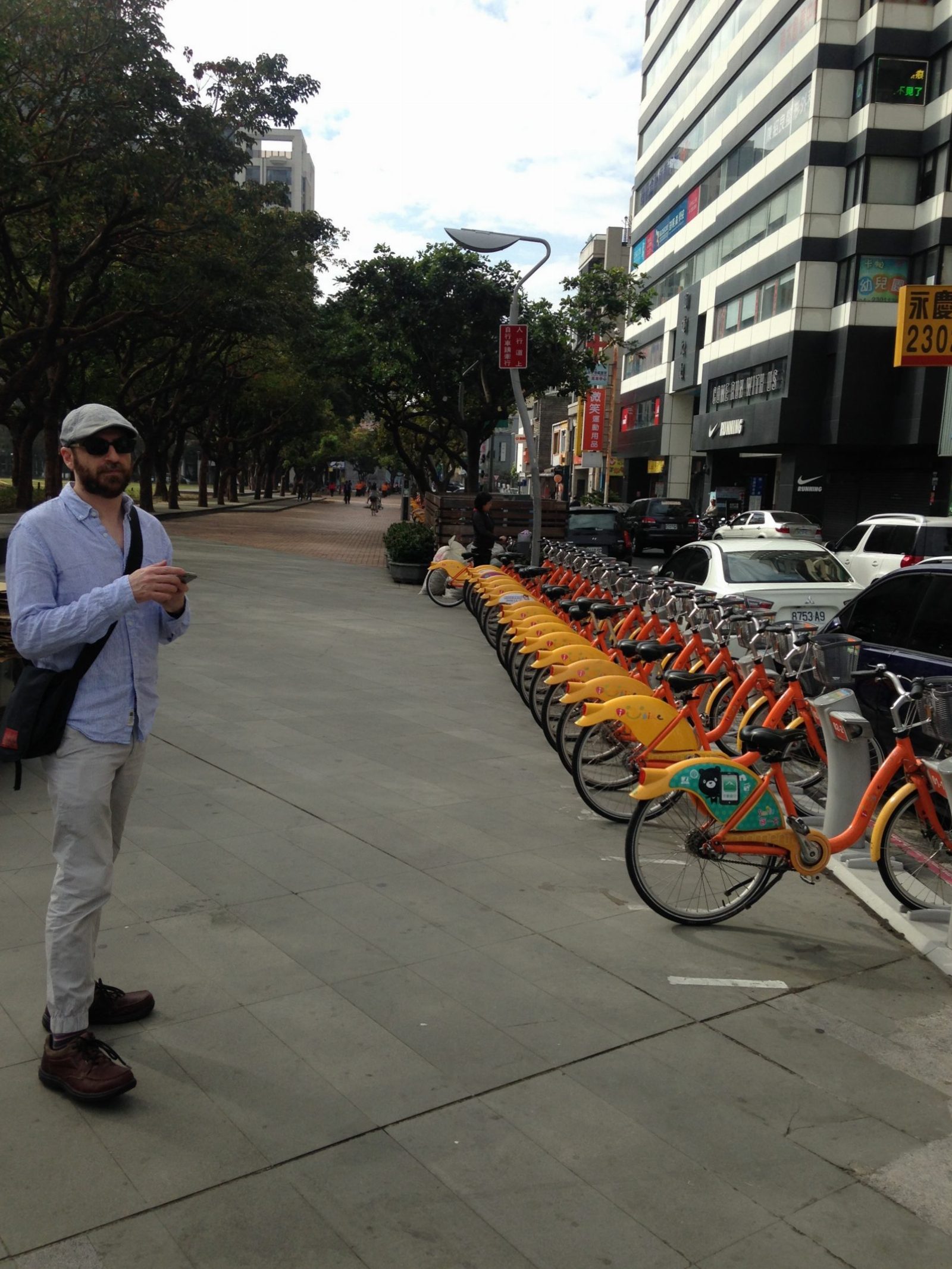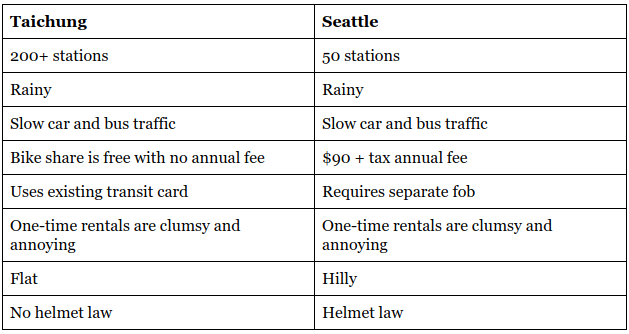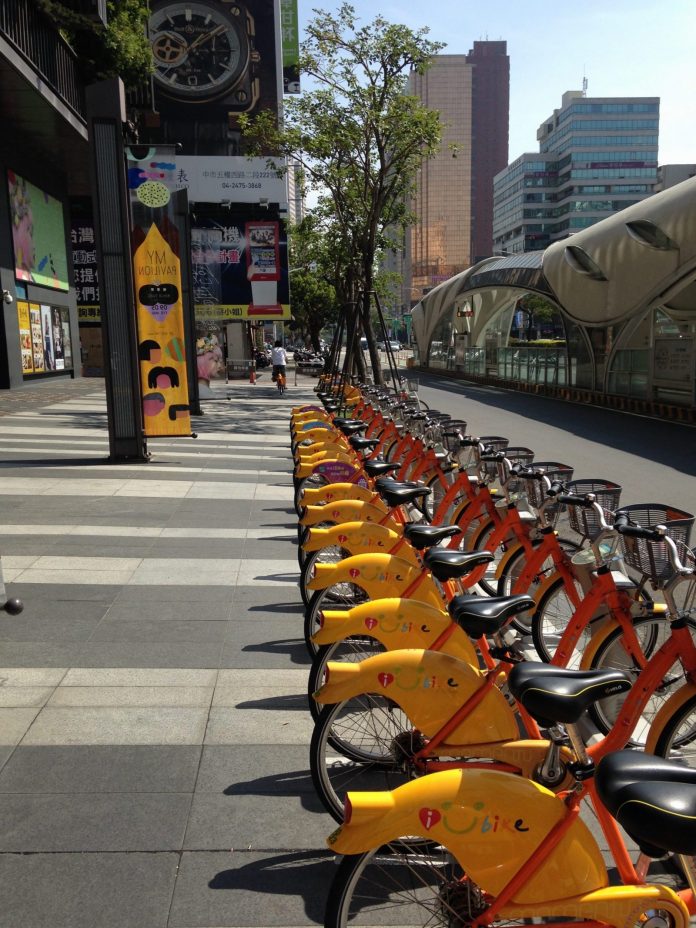Here’s what I know about cycling, based on stuff Seattle people say:
- Without good cycling infrastructure, the only people who’ll venture out on a bike are spandex-encased No Fear types.
- Even they won’t cycle in the rain.
Taichung is a city of 2.75 million (a little smaller than the Seattle metro area), the third-largest in Taiwan. The primary mode of transportation is the motor scooter. At every red light, scooters accumulate at the stop line, revving and ready to roll as soon as the light turns green. The large intersections, like along Taiwan Boulevard near the National Museum of Natural Science, look like Shibuya Crossing in Tokyo, but with scooters instead of pedestrians.
Amid this chaos, you’ll also see a whole lot of orange bicycles. They’re part of the iBike system, which boasts over 200 stations and thousands of bikes. Borrowing an iBike is as easy as tapping your transit card, and trips under 30 minutes are free. Helmets are not provided, and no one uses them. Unlike other systems like Paris’s Vélib or New York’s CitiBike, iBike has no membership fee. Anyone—visitor or resident—with a local SIM card and a transit card can sign up.
I spent a week in Taichung in February. I don’t have a driver’s license, and I wouldn’t have dared to get on a scooter in any case. There’s a dedicated bus lane along Taiwan boulevard, but buses on any other route are slow and get stuck in traffic. (Amazingly, buses are also free for the first 10km per day.) So I used iBike a lot. Signing up took two minutes on the website, and it was so easy, I was sure nothing would happen when I scanned my card at the massive bike station in front of the Park Lane by Splendor shopping mall on Taiwan Boulevard. But my bike released with a satisfying click.
Every large city in Taiwan has a bikeshare system, including C-Bike in Kaohsiung, T-Bike in Tainan, and the largest, YouBike in Taipei. A single membership is good on all of these systems. The EasyCard is good on trains, buses, and bikes throughout the country. I can already hear American transit planners explaining why this could never happen here; meanwhile, in Asia they just do it.
Bikeshare in Taiwan is enormously successful. I was not among the first 7 million members in a nation of 23 million people. I was staying in central Taichung and saw orange iBikes going by at all times—even in the rain, when bicycle and scooter riders just put on a poncho and go.

One day, my wife Laurie and I took the bus to Taichung Park, two miles from where we were staying. The bus ride took about twenty minutes. We visited a friend’s soy milk shop and got delicious fruit shakes on Yizhong Street. It started raining hard, so we dashed to the bus shelter—and waited fifteen minutes with no sign of our bus. When the rain let up, we decided to take iBike instead. The nearest station was a block from where we were standing. (Like nearly every bikeshare system in the world, iBike is compatible with the free Spotcycle app for Android and iOS, which makes it easy to find a station and see how many bikes and empty docks are available in real time.)
We checked out bikes and rode through Taichung, stopping occasionally to check directions or peer into an interesting shop window. Even with these pauses, and even though I made a wrong turn and took us a few blocks out of our way, the trip back was pleasant and faster than the bus.
It’s hard to explain why Taichung should be a good place to ride a bike. Painted bike lanes are rare (and in most cases are shared by bikes and scooters). Separated bike lanes are almost nonexistent. Pedestrian infrastructure is lousy: many downtown streets lack sidewalks, and where you do find sidewalks, they’re frequently obstructed by parked scooters, arcade columns, and other obstacles. Scooters are ubiquitous. On a typical ride, you’ll switch back and forth between the sidewalk and the road, riding slowly and darting among pedestrians, scooters, and cars. As many observers have noted in Taipei, pedestrian-bicycle conflicts are frequent.
In other words, there’s a lot about Taichung urbanism that I wish were different. At the same time, I never felt like I was in danger as a cyclist or pedestrian. I’ve been to places where traffic is genuinely chaotic and scary (hello, Thailand), and Taiwan offers more of a controlled chaos: drivers stop at red lights, watch for (but don’t yield to) pedestrians and bicycles, and generally seem hyperaware compared to distracted-driving Seattleites. Also, right turn on red is illegal in Taiwan, and most drivers follow the law.
Bikeshare in Seattle is going away at the end of this month. What went wrong? Let’s take inventory and see if we can spot any clues.

There’s obviously nothing scientific about this comparison, but it would be hard to dispute that more people will use a bikeshare system when it’s free, integrates with the local transit card, and doesn’t require helmets. Seattle could do all of those things.
As for hills, I live on top of Capitol Hill and would love to zip home from downtown on an electric-assist shared bike like people do in Madrid. But there’s no reason non-electric bikeshare can’t work in a hilly city, either. It may seem silly to cart loads of bikes uphill in a truck, but it’s no different from a bus route that runs full in one direction and empty in the other. In either case, you’re replacing a bunch of fossil-fueled trips with one.
I don’t know whether bikeshare will ever return to Seattle. I certainly hope so, because I use Pronto several times a week, and it’s really going to suck when it’s gone. If and when it does come back, let’s take a few lessons from our Pacific Rim counterpart.



